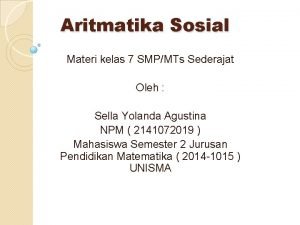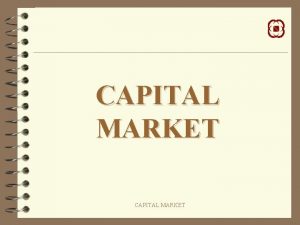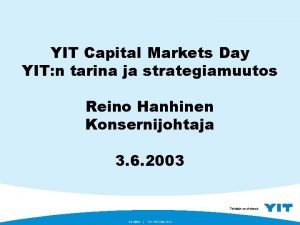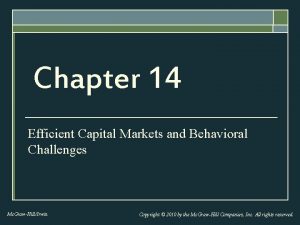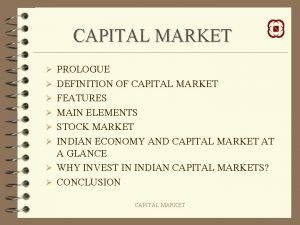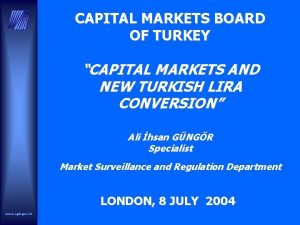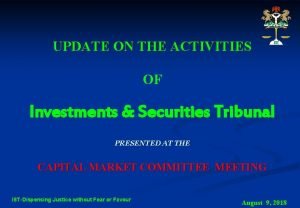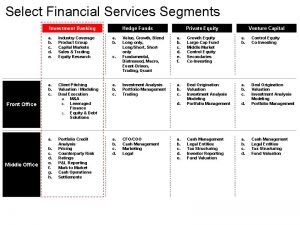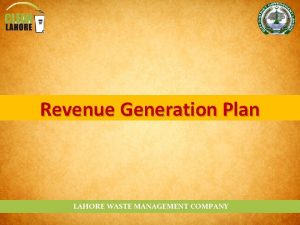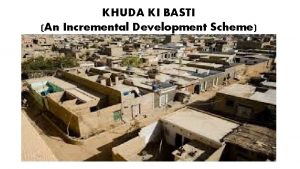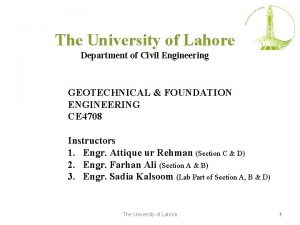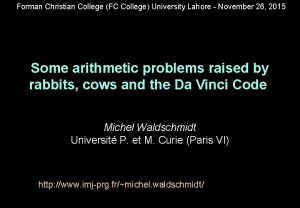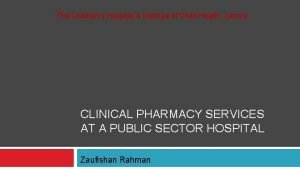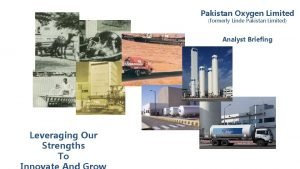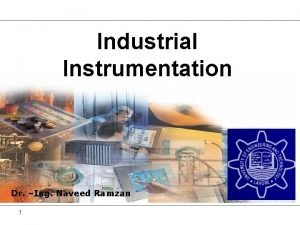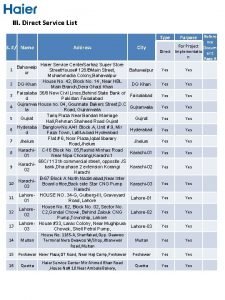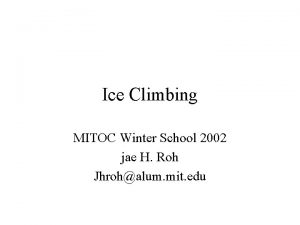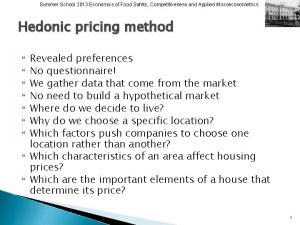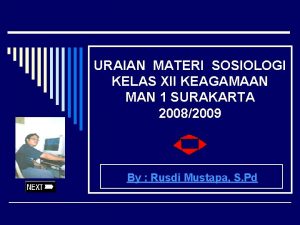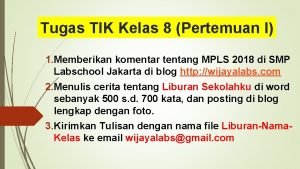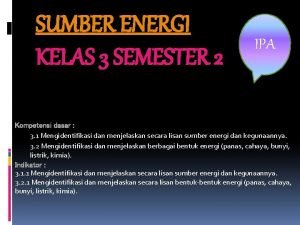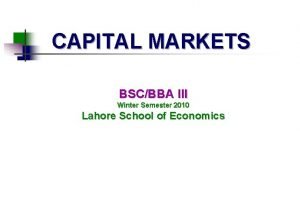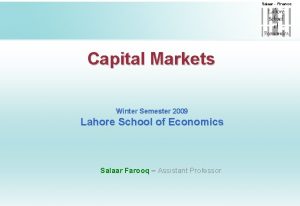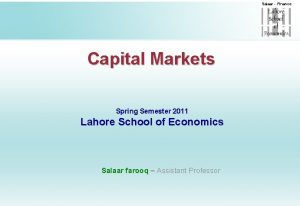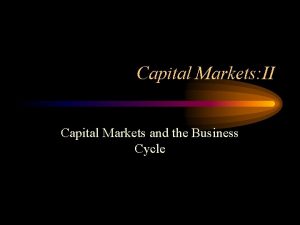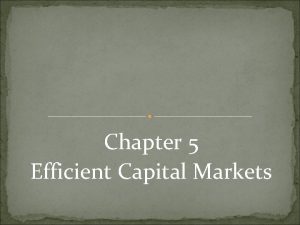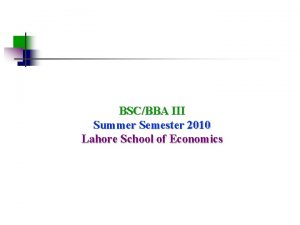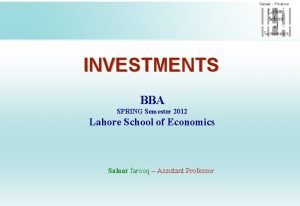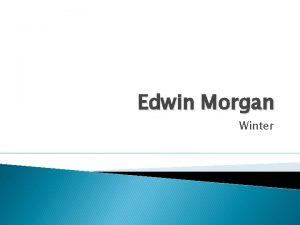Capital Markets Winter Semester 2013 Lahore School of
























































- Slides: 56

Capital Markets Winter Semester 2013 Lahore School of Economics

Common Stock Valuation

Chapter 10 Common Stock Valuation Learning Objectives n Common Stock Valuation n Dividend Growth model n Zero Growth n Constant Growth n Multiple growth model n Intrinsic Value & Market price n Relative Valuation Techniques (P/E, P/S) n Components of Required Return

Capital Market Securities n Fixed Income (Bonds) n Treasuries n Agencies n Municipals n Corporates n Equities n Preferred Stock n Common Stock

Stocks n It is an equity ownership in a corporation, initially issued to raise capital n Points to keep in mind (vs Bonds) n C/F’s are NOT known in advance n Life of stocks is forever – no maturity n Difficult to observe required rate of return for discounting

Stocks n How do we come up with the Price of a Stock? PV of all future expected C/F’s? n Assumptions will be needed! n Assume a dividend the stock will pay. n Come up with a required rate of return.

Dividend growth model Value of a stock is the present value of the future dividends expected to be generated by the stock.

Stocks Valuation Formula: Po = E Dn / (1+R)^n PV of all future dividends… as a general valuation framework. Dividends to infinity are still a problem at this stage!

Stocks Valuation The problem of NO dividends…. This formula assumes the company will pay something at some point in its life to its shareholders. A Corp where money goes in but nothing comes out doesn’t exist. Or shouldn’t exist!

Stocks Valuation Special Cases…. of dividends Zero-growth: Here the dividend is constant, D 1=D 2=D So, the value of the stock is a Perpetuity (ordinary), Po = D/R same as PV = C/r

Stocks Valuation Example zero-growth Suppose a company pays Rs. 10 dividend always. If this policy is forever, … What’s the stock price if the required return is 20%?

Stocks Valuation Example zero-growth Suppose a company pays Rs. 10 dividend always. If this policy is forever, … What’s the stock price if the required return is 20%? Po = 10 / 0. 2 = Rs 50 per share

Stocks Valuation Zero Growth Example: A company pays a dividend of $2 per share, which is not expected to change. Required return is 20%. What’s the price per share today?

Stocks Valuation Zero Growth Example: A company pays a dividend of $2 per share, which is not expected to change. Required return is 20%. What’s the price per share today? Po = Do / k 2/. 2 = 10

Stocks Valuation Special Cases…. of dividends Constant Growth Model: Suppose the dividend grows at a constant rate g. If dividend just paid is Do, then the next D 1 is: D 1 = Do x (1+g) & for 2 periods is: D 2 = Do x (1+g)^2 D 2 = (Do x (1+g)) x (1+g) (FV formula)

Stocks Valuation Growing Perpetuity: An asset where the C/F’s grow at a constant rate forever. Po = Do x (1+g) / R-g OR D 1 / R - g (g<R)

Stocks Valuation Example: Suppose Do = 2. 30, R=13%, g=5%. Whats the price per share?

Stocks Valuation Example: Suppose Do = 2. 30, R=13%, g=5%. Whats the price per share? D 1 / R - g (g<R) 2. 3 x (1. 05) / (0. 13 -0. 05) 2. 415 / 0. 8 = 30. 19

Stocks Valuation Note: You can use this to find the stock price at any point in time! Just find the D for that year, grow it at (1+g) & then divide by R-g

Stocks Valuation Example: Suppose Do = 2. 30, R=13%, g=5%. What’s the price per share in 5 years? D 6 / R - g (g<R)

Stocks Valuation Example: Suppose Do = 2. 30, R=13%, g=5%. What’s the price per share in 5 years? D 6 / R - g (g<R) 2. 3 x (1. 05)^5 / (0. 13 -0. 05) 2. 935 x(1. 05) / 0. 8 = 3. 0822/. 08 = 38. 53

Stocks Valuation Example: Suppose Company T’s next dividend will be $4. Required return is 16%. Dividend increases by 6% every year. What’s the price per share today? & in 4 years?

Stocks Valuation Example: Suppose next dividend will be $4. Required return is 16%. Dividend increases by 6% every year. D 1 = 4 , R=16%, g=6%. (since D 1 is given, don’t need to grow by g) What’s the price per share today? Po = D 1 / R - g (g<R) 4/ (. 16 -. 06) = 4/. 1 = $40 = Po What’s the price per share in 4 yrs? Find D 5 first, D 1 (1+g)^4 = 4(1. 06)^4 = 5. 05/0. 1 = 50. 50 = P 4

Stocks Valuation Notice here: P 4 = Po (1+g)^4 50. 50 = 40 x (1. 06)^4 So, Stock price grows at the same constant rate as the Dividend! P 4 is simply D 5/(R-g)

Stocks Valuation Constant growth Example: Suppose ODGC pays a dividend of Rs. 2 per share which is expected to grow at a constant rate of 7% per year. Investors require a rate of return of 16% given the risk of this stock. D 1 = 2*(1. 07) = 2. 14 , R=16%, g=7%. What’s the price per share today? What’s the price per share in 4 yrs?

Stocks Valuation Constant growth Example: Suppose ODGC pays a dividend of Rs. 2 per share which is expected to grow at a constant rate of 7% per year. Investors require a rate of return of 16% given the risk of this stock. D 1 = 2*(1. 07) = 2. 14 , R=16%, g=7%. What’s the price per share today? Po = D 1 / R - g (g<R) 2. 14/ (. 16 -. 07) = 23. 78 = Po What’s the price per share in 4 yrs? Find D 5 first, D 1 (1+g)^4 = 2. 14(1. 07)^4 = 2. 81/. 09 = Rs 31. 22 = P 4

If r. RF = 7%, r. M = 12%, and β = 1. 2, what is the required rate of return on the firm’s stock? Use the SML to calculate the required rate of return (ks): rs = r. RF + (r. M – r. RF)β = 7% + (12% - 7%)1. 2 = 13%

If D 0 = $2 and g is a constant 6%, find the expected dividend stream for the next 3 years, and their PVs. 0 g = 6% D 0 = 2. 00 1. 8761 1. 7599 1. 6509 1 2 2. 12 2. 247 rs = 13% 3 2. 382

What is the stock’s market value? Using the constant growth model:

What is the expected market price of the stock, one year from now? D 1 will have been paid out already. So, P 1 is the present value (as of year 1) of D 2, D 3, D 4, etc. Could also find expected P 1 as:

What is the expected dividend yield, capital gains yield, and total return during the first year? Dividend yield = D 1 / P 0 = $2. 12 / $30. 29 = 7. 0% Capital gains yield = (P 1 – P 0) / P 0 = ($32. 10 - $30. 29) / $30. 29 = 6. 0% Total return (rs) = Dividend Yield + Capital Gains Yield = 7. 0% + 6. 0% = 13. 0%

Components of Required Return Let’s break down the R, discount rate which we used in the Dividend Discount Model or DDM Po = D 1 / (R-g) if we rearrange to solve for R…. then… R-g = D 1/Po R = D 1/ Po + g

Components of Required Return R = D 1/ Po + g This means TR has 2 components: D 1/Po = Dividend Yield g = same rate as the increase in stock price = Capital gains yield

Components of Required Return EXAMPLE R = D 1/ Po + g If a stock is selling for $20 per share. Next dividend will be $1 per share. Dividend will grow by 10% per year forever. What is the return on this stock?

Components of Required Return EXAMPLE R = D 1/ Po + g If a stock is selling for $20 per share. Next dividend will be $1 per share. Dividend will grow by 10% per year forever. What is the return on this stock? R = Div yield + Cap gains yield = 1/20 + 10% = 5% + 10% = 15%

Components of Required Return EXAMPLE R = D 1/ Po + g A stock’s dividend will grow by 8% per year forever. If the stock is selling for $60 per share and next dividend will be $3 per share. What is the required return on this stock?

Components of Required Return EXAMPLE R = D 1/ Po + g A stock’s dividend will grow by 8% per year forever. If the stock is selling for $60 per share and next dividend will be $3 per share. What is the required return on this stock? R = Div yield (D 1/Po) + Cap gains yield (g) = 3/60 + 0. 08 = 0. 05 +. 08 = 13%

Salaar - Finance PART II

Stocks Valuation Multiple Growth model Company grows at a certain high rate first, then slows down to grow at a constant sustainable rate.

Supernormal growth: What if g = 30% for 3 years before achieving long-run growth of 6%? Can no longer use just the constant growth model to find stock value. However, the growth does become constant after 3 years. Terminal Date (Horizon date): the date when the growth becomes constant. At this date it is no longer necessary to forecast the individual dividends. Horizon(Terminal value): the value at the horizon date of all dividends expected thereafter.

Four steps for applying non constant growth model Find the PV of the dividends during the period of non constant growth. Find the price of the stock at the end of the non constant growth period, at which point it has become a constant growth stock. Discount this price back to the present Add these two components to find the intrinsic value of the stock. (expected price)

Valuing common stock with nonconstant growth 0 rs = 1 13% g = 30% 2 g = 30% D 0 = 2. 00 2. 600 3 g = 30% 3. 380 4 g = 6% 4. 394 . . . 4. 658 2. 301 2. 647 3. 045 46. 114 54. 107 ^ = P 0 P$ 3 = 4. 658 0. 13 - 0. 06 = $66. 54

Find expected dividend and capital gains yields during the first and fourth years. Dividend yield (first year) = $2. 60 / $54. 11 = 4. 81% Capital gains yield (first year) = 13. 00% - 4. 81% = 8. 19% During nonconstant growth, dividend yield and capital gains yield are not constant, and capital gains yield ≠ g. After t = 3, the stock has constant growth and dividend yield = 7%, while capital gains yield = 6%.

Nonconstant growth: What if g = 0% for 3 years before long-run growth of 6%? 0 rs = 13% g = 0% 1 2 g = 0% D 0 = 2. 00 3 g = 0% 4 g = 6% . . . 2. 12 2. 00 1. 77 1. 57 1. 39 20. 99 25. 72 ^ = P 0 P$ 3 = 2. 12 0. 13 - 0. 06 = $30. 29

If the stock was expected to have negative growth (g = -6%), would anyone buy the stock, and what is its value? The firm still has earnings and pays dividends, even though they may be declining, they still have value.

Stocks Valuation Intrinsic Value & Market Price If IV > Mkt Price = under/over-valued? IV < Mkt Px = under/over valued?

Stocks Valuation Multiple growth Example: MCB is expanding and is expected to grow at a rate of 20% per year for the next three years. Current dividend is Rs. 2 per share. After this rapid growth, the company is likely to slow down to a normal growth of 7% for the foreseeable future. Required return on this stock is 22%. D 1 = 2*(1. 20) = 2. 40 , R=22%, G 1= 20%, g=7%. What’s the price per share today?

Relative Valuation Techniques P/E = Price to Earnings ratio P/E = Stock Price / EPS • Gives a idea of what the market is willing to pay for the company’s earnings. • The higher the P/E ratio , the more the market is willing to pay for company’s earnings and vice versa. • A high P/E ratio gives an indication that an investor has high hopes for this stock’s future and has bid up the price , which makes the stock over valued.

Relative Valuation Techniques Determinants of P/E Po = D 1 / k – g P/E 1 = D 1/E 1 / k – g The ratio: expected dividend payout ratio D 1/E 1 The required rate of return The expected growth rate in dividends. “Other things being equal”

Relative Valuation Techniques P/E The ratio and interest rates: higher the risk , the lower would be the P/E ratio. As the investor require a higher required rate of return which eventually reduced the P/E ratio. The required rate of return is related to interest rates. When interest rates increases, bonds become more attractive than the stocks. Therfore, as interest rate rise (decline), other things being equal , P/E ratios should decline (rise).

Valuation using the P/E ratio: Stock price is a product of 2 variables: EPS The P/E multiple Po= Eo * Po/Eo E 1= Eo(1+g) P 1= E 1 * P 1/E 1

Forward P/E = Po/E 1

Relative Valuation Techniques Price/Book Value: P/B= Share price/ Book value per share Price/ How Sales ratio: much revenue you get per dollar invested. Price/Sales ratio = Stock price/revenue/share Or Price/sales ratio= Total market value/ annual

Economic value added (EVA) EVA = NOPAT – Annual dollar cost of capital EVA= NOPAT- after tax dollar cost of capital used to support operations =EBIT(1 -tax rate)-[total net operating capital*(after tax cost of capital)] EVA measures the extent to which the firm has increased shareholder value In order to generate positive EVA, a firm has to more than just cover operating costs. It must also provide a return to those who have provided the firm with capital. EVA takes into account the total cost of capital, which includes the cost of equity.

Question The ABC corporation has on its balance sheet $ 5 million in net operating capital and $ 37 million in net fixed assets. The company’s weighted average cost of capital is 8. 5 percent. The company has the following statement: Sales ` $25, 000 Operating costs 18, 625, 000 EBIT 6, 375, 000 Interest 2, 325, 000 EBT 4, 050, 000 Taxes(40%) 1, 620, 000 Net income 2, 430, 000 What is ABC’s EVA?

In class practice of Ch-10 NEXT: STOCKS ANALYSIS & STRATEGY
 Aritmatika sosial smp kelas 7
Aritmatika sosial smp kelas 7 Winter kommt winter kommt flocken fallen nieder
Winter kommt winter kommt flocken fallen nieder Es ist kalt es ist kalt flocken fallen nieder
Es ist kalt es ist kalt flocken fallen nieder Es ist kalt es ist kalt flocken fallen nieder
Es ist kalt es ist kalt flocken fallen nieder Structure of capital market in india
Structure of capital market in india Yit capital markets day
Yit capital markets day Efficient capital markets and behavioral challenges
Efficient capital markets and behavioral challenges Feature of capital market
Feature of capital market Savers and investors role in financial markets
Savers and investors role in financial markets Financial markets and the allocation of capital
Financial markets and the allocation of capital Capital markets board of turkey
Capital markets board of turkey Investment and securities tribunal
Investment and securities tribunal Investment banking hours
Investment banking hours Efficient capital markets ii
Efficient capital markets ii Revenue generation plan
Revenue generation plan Qarar dad pakistan in urdu
Qarar dad pakistan in urdu Khuda ki basti lahore
Khuda ki basti lahore Bearing capacity of soil in lahore
Bearing capacity of soil in lahore Fibonacci lahore
Fibonacci lahore University of health sciences lahore events
University of health sciences lahore events Children's hospital lahore
Children's hospital lahore Pakistan oxygen limited lahore
Pakistan oxygen limited lahore Song
Song Ambala bakery quetta
Ambala bakery quetta Sky bus technology seminar ppt
Sky bus technology seminar ppt Lahore film industry
Lahore film industry Lahore metro bus route length
Lahore metro bus route length Senior high school subjects (per semester)
Senior high school subjects (per semester) Mary is trying hard in school this semester her father said
Mary is trying hard in school this semester her father said Track and strand
Track and strand Senior high school subjects (per semester)
Senior high school subjects (per semester) Introduction of working capital
Introduction of working capital Difference between capital reserve and reserve capital
Difference between capital reserve and reserve capital Multinational cost of capital and capital structure
Multinational cost of capital and capital structure Difference between capital reserve and reserve capital
Difference between capital reserve and reserve capital Basle ii
Basle ii Regulatory capital vs economic capital
Regulatory capital vs economic capital Constant capital and variable capital
Constant capital and variable capital Multinational cost of capital and capital structure
Multinational cost of capital and capital structure Capital allocation line vs capital market line
Capital allocation line vs capital market line School bus
School bus Mitoc winter school
Mitoc winter school Winter law school elsa
Winter law school elsa School crossing patrol winter coat
School crossing patrol winter coat Summer school 2013
Summer school 2013 Materi sosiologi kelas 12 semester 2
Materi sosiologi kelas 12 semester 2 Materi desain grafis kelas 10 semester 2
Materi desain grafis kelas 10 semester 2 Us history semester 2 final exam
Us history semester 2 final exam Tugas tik kelas 9 semester 2
Tugas tik kelas 9 semester 2 Materi tik kelas 8
Materi tik kelas 8 Chemistry semester 2 review unit 12 thermochemistry
Chemistry semester 2 review unit 12 thermochemistry Kompetensi dasar kelas 3 semester 2
Kompetensi dasar kelas 3 semester 2 Keadaan alam vietnam
Keadaan alam vietnam Semester in san francisco
Semester in san francisco English 3 semester exam
English 3 semester exam Semester a exam part 1
Semester a exam part 1 Pointing
Pointing
